The hardest part of a pregnancy is the first trimester (first 3 months of the preggie)- let’s just say your whole life takes a turn in a direction you think is a dream. Your partner doesn’t know what happened to their loving girlfriend/wife because there is a vomiting, highly
impossible, tired, emotional wreck that can cut your balls with one word.
When you find out about the baby; you may find out by a couple of symptoms that are different for each woman – simply called morning sickness. Just because it is called “morning” doesn’t mean this “sickness” happens in the morning. It hits anytime, anywhere! For some lucky women, this lasts only the first trimester whilst for others – it may be for longer.
Morning Sickness Vomiting; not being able to keep anything down. Whenever and whatever time.
Metallic taste; everything tastes like metal! So eating is a bit of a challenge.
Sleep; you are forever tired – even you sleep 20 hours, you are still tired! You sleep everywhere!
Moody; damn! No-one can say or do something without you biting their head off
Loo visits; you are forever needing to pee, even after you have just left the loo.
Tender breasts; you gals just slightly hurt and seem to be growing.
Dizziness; feeling lightheaded even you stand up too quickly or wake up in the morning
Tight waistlines; you clothes simply feel tighter around your midriff
Missed period; dead sign that you have a special surprise on the way.
The worst part is no-one can tell that you are preggies, so people assume you are just a mean horrible miserable person. Sadly, most guys leave their girlfriends at this time as they seem to think she is just an impossible human being that he doesn’t need to burden himself with. Even by the time she discovers she is preggies, brother-man has decided she is too much crap to stick around with.
The best part about this stage of pregnancy is the knowledge of the secret (if you are not announcing it) and the breast size (the gals grow to a larger size that gives you a nice cleavage).
Pregnancy can be detected by a home pregnancy test, a gynaecological check-up or a GP taking a blood test. The fastest and easiest way is to buy a home pregnancy and seeing the blue or pink line change. Even after doing this, you still need to get a GP or Gynae to verify that the home pregnancy test was correct. When you have confirmed the pregnancy, you will be given folic acid tablets which will assist with the development of the baby’s spine. This is very important!
After the first gynae check-up, you will visit every 4 weeks for the doctor to check the baby’s development and run tests for spinal development, down syndrome and any other related stuff.
Technical feotal development and pictures sourced the information from www.Pampers.co.za and www.discoveryhealth.co.za (Did not want to assume I know the biological changes but felt they were important for anyone that is at this stage, my apologies)
Week 2 – 4 Pregnancy is counted from the first day of your period, so technically at this stage your last period would have just started. This means at the time you conceive (two weeks from the date your period started), your baby is already considered two weeks old.
At the end of the second week, one of the eggs formed in the ovaries is swept into the fallopian tube. During conception, the sperm and egg join in the fallopian tube to form a zygote (a fertilised egg). Forty-six chromosomes - the microscopic structures that transmit hereditary characteristics - combine to create a unique human being. During this time, oestrogen serves as a trigger that causes the uterus to form a blood-rich lining of tissue.
The zygote moves from the fallopian tube to the uterus. Once in the uterus, the developing embryo - now called a blastocyst - searches for a place to implant, where it actually burrows beneath the surface of the uterus. Your body releases an immunosuppressant protein, called Early Pregnancy Factor (EPF), which prevents your body from rejecting the baby as an intruder.
You may experience a slight bit of spotting at this time. This is called implantation bleeding and is caused by the fertilised egg burrowing into the uterus. It is completely normal and nothing to worry about.
Your unborn child is only 1.7mm long during this stage, but it is developing rapidly. The backbone, spinal column, and nervous system are forming and the kidneys, liver and intestines are also starting to take shape.
Week 4 – 8 By the end of week 4, you will notice that you have missed your period. This is because the developing embryo produces hormones to stop the mother's menstrual cycle. You may be feeling tired, urinating more frequently and having mood swings, while your breasts may be swollen and tender.
On the back of the embryo, a sheet of cells folds in the middle to form a tube - the beginning of the spinal cord. The embryo is smaller than a grain of rice - about 2.5 mm in length. By day twenty-one, the embryo's tiny heart has begun beating. The embryo is divided into 3 layers.
The first layer, called the neural tube, enlarges into three parts, soon to become a very complex brain.
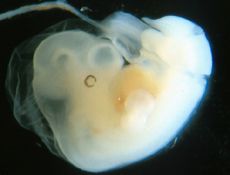 Week 6 scan
Week 6 scan
From the second layer, the heart and circulatory systems start to develop. The lungs, intestines and the urinary system begin developing from the third layer.
The placenta - the blood-rich lining of your uterus - begins functioning, providing oxygen and nutrition for the foetus. The spine and spinal cord grow faster than the rest of the body at this stage and look almost like a tail. This "tail" will disappear as the embryo continues to grow.
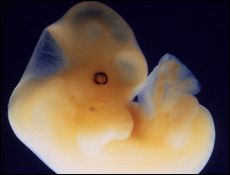 Week 7 Scan
Week 7 ScanYour baby's facial features, including the mouth and tongue, are now becoming visible. The retina and lenses of your baby's eyes also start to develop. The major muscle system is developed, and your baby begins to move around.
The limb buds continue developing, but the fingers and toes have not yet started to develop. Compared to the rest of its body, the baby's head is oversized.
Your child has its own blood type now, distinct from yours. These blood cells are produced by the liver and not by the yolk sac.
Week 8 - 12
The unborn baby, called a foetus at this stage, is now about 8-11 mm long from crown-to-rump. Inside the protective fluid of the amniotic sac, it swims and moves gracefully. The arms and legs have lengthened, elbows appear and toes and fingers with a slightly webbed appearance can be seen. It is now possible to measure brain waves and teeth begin to develop inside the gums.
You may feel tired during the first months of your pregnancy, so rest if you need to. It is also normal to feel excited, happy, worried and concerned - sometimes all at the same time!
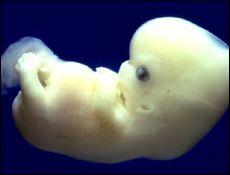 Week 9 scan
Week 9 scanThe length of the foetus is 22 to 30mm - approximately the size of a medium green olive. Although you cannot feel it, your baby now moves its body and limbs and this movement may be seen during an ultrasound examination. The baby looks more like a human being and has lost its "shrimp-like" appearance, but it is still extremely small.
You will not yet be able to distinguish a male from a female on an ultrasound, because the external genitalia of the male and female still appear very similar. The toes are beginning to lose their webbed appearance and the hands now bend at the wrist. The foetus is not yet conscious, but nerve endings in the brain have begun to grow. You may begin to notice a thickening in your waist (although you probably haven't gained much weight yet) and your breasts will have grown larger.
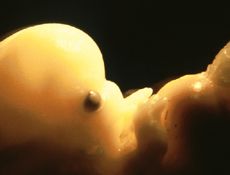 week 10 scan
week 10 scan The foetus is approximately 3.5 cm long. The heart is almost completely developed and very nearly resembles that of a newborn baby.
An opening of the atrium of the heart and presence of a bypass valve diverts much of the blood away from the lungs, as the foetus's blood is oxygenated through the placenta.
Twenty tiny baby teeth are forming in the gums. By the end of the week, the tail will have disappeared, the toes will be distinct, and the fingers longer. The eyelids are developing and will begin to fuse. External ears are developed as well as the upper lip. The foetus 's genitals are beginning to develop.
If you are over 35, or have a family history of genetic illnesses, you may consider a Chronic Villus Sampling (CVS) - an antenatal test usually given between 10-12 weeks that screens for birth defects and abnormalities.
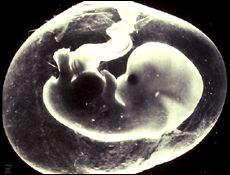 Week 11 Scan
Week 11 ScanThe foetus is about 5-7 cm long crown-to-rump. Foetal growth is rapid now and the length of your baby will double in the next 3 weeks. The head is almost half the baby's entire length at present and as the head extends (uncurls or tips backward toward the spine), the chin rises from the chest and the neck develops and lengthens.
Fingernails begin to appear on your baby's fingers. By now, the placenta will be providing enough hormones to support your pregnancy and by the end of this week, your baby will start producing urine.
If you have been experiencing morning sickness, this will probably come to an end soon. Your breasts will have grown larger and your abdomen may be more rounded. You may feel like you are riding on an emotional roller coaster ride and you may be feeling moody one day and joyful the next. Your up-and-down emotions are partially caused by raging hormones and are a normal part of pregnancy.
If you have been experiencing tiredness and nausea, this should come to an end soon. You still need to take good care of yourself though, so always wear your seat belt when you are in a car. The shoulder harness should go between your breasts and the lap belt under your stomach.
Most women can safely enjoy sex during pregnancy. If you do suffer any discomfort or have any concerns, talk to your health care provider. During this time, you may notice a dark line of pigmentation - called the Linea Nigra - on your abdomen. Don't be concerned, it is normal and usually fades after birth.
You should continue to exercise while you are pregnant. This can help to alleviate some of the discomfort commonly felt in pregnancy, such as fatigue, constipation, backache, leg cramps and breathlessness. If you continue to do prenatal exercise you will be more likely to return to your pre-pregnancy figure quickly than if you had remained sedentary during the nine months. However, pregnancy is not the time to start new exercises or to continue doing very high impact aerobic or strenuous exercises (like water skiing or contact sports). A good form of exercise during pregnancy is walking or cycling on a stationery bike. Some medical conditions (e.g. diabetes or pulmonary disorders) may require you to stop exercising or to change your exercise patterns. Before you commence with any exercise, check with your doctor who will be able to advise what exercise is safe for you and the baby.
Meanwhile, your baby is still growing fast - it is now about 6cm long and weighs around 18 grams. The vocal chords are now fully developed and your baby may sometimes cry silently in the womb. The brain is fully formed and the foetus can feel pain. The child is starting to open and close its mouth and move it its tiny hands, legs and head, although you cannot feel this. Your baby may sometimes even suck its thumb.
The toes and fingers are complete and hair follicles and tear ducts are formed. The eyelids now cover the eyes and will remain shut until the seventh month to protect the delicate optical nerve fibres. Your baby starts to swallow amniotic fluid and waste products are transferred to your blood stream through the placenta.